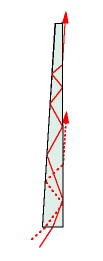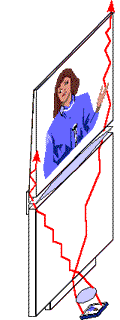
|
|
||||||||
A Better View
|
It may come as a surprise to know that the optimum screen size for TV viewers is considered to be one with a diagonal measuring in the region of 50 inches. Most houses in Europe and Asia can only accommodate such a screen if it is flat, when it could conveniently hang on a wall, for instance. The race is on, therefore, to produce such a technological marvel. Researchers in the Sensors and Photonics group under the leadership of Dr Adrian Travis are very excited about the prospects of their latest way of achieving this objective, a simple device known as the Wedge. The WedgeThe Wedge refers to a wedge-shaped slab of glass which forms the screen of the display. Images are projected onto this screen using the same principles as those used for waveguides or optical fibres. A light ray injected at a shallow angle into the thick end of the wedge travels inside the glass, bouncing off each air/glass interface as shown in the diagrams. Each time the ray is reflected off the angled interface, the ray's direction changes. Its angle at the glass/air interface becomes progressively less shallow, as shown, until it becomes so steep that the total internal reflection breaks down and the ray emerges. By using a series of lenses to firstly focus the rays from a video projector to a point within the wedge and then travel along it before leaving the face at the appropriate points, a magnified image can be formed. This method essentially provides a method of back projection display which is much thinner (< 25mm) than those currently available. |
|

